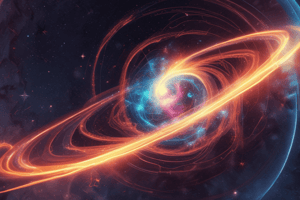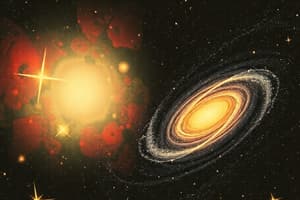Podcast
Questions and Answers
Which process is NOT considered a primary mechanism for the formation of elements in the universe?
Which process is NOT considered a primary mechanism for the formation of elements in the universe?
- Big Bang nucleosynthesis
- Artificial synthesis in laboratories
- Fusion reactions within stars
- Weathering of rocks on planets (correct)
What role does the high temperature in stars play in the creation of elements?
What role does the high temperature in stars play in the creation of elements?
- It prevents the formation of heavier elements.
- It neutralizes the charge of atomic nuclei.
- It overcomes electrostatic repulsion between positively charged nuclei. (correct)
- It slows down nuclear fusion.
Why is Beryllium-8 (⁸Be) considered an unstable intermediate in stellar nucleosynthesis?
Why is Beryllium-8 (⁸Be) considered an unstable intermediate in stellar nucleosynthesis?
- It requires extremely high temperatures to form.
- It is only formed in artificial synthesis.
- It immediately decays back into two helium nuclei. (correct)
- It has too many neutrons.
What primarily influences the relative abundance of elements in the universe?
What primarily influences the relative abundance of elements in the universe?
What is a cyclotron primarily used for in the laboratory synthesis of elements?
What is a cyclotron primarily used for in the laboratory synthesis of elements?
Why are only a fraction of the known elements found in living cells?
Why are only a fraction of the known elements found in living cells?
How does the concentration of ions in seawater relate to the ionic composition of blood plasma?
How does the concentration of ions in seawater relate to the ionic composition of blood plasma?
Which group of elements is most abundant in organic compounds within cells?
Which group of elements is most abundant in organic compounds within cells?
What characteristic distinguishes trace elements from major or bulk elements in biological systems?
What characteristic distinguishes trace elements from major or bulk elements in biological systems?
Which of the following is NOT a typical characteristic of the major elements found in biological systems?
Which of the following is NOT a typical characteristic of the major elements found in biological systems?
What is catenation, and which element exhibits this property to the greatest extent?
What is catenation, and which element exhibits this property to the greatest extent?
Why is carbon more prevalent in living organisms than silicon, despite silicon being more abundant in the Earth's crust?
Why is carbon more prevalent in living organisms than silicon, despite silicon being more abundant in the Earth's crust?
Nitrogen has five valence electrons and can form bonds, why are extended chains of nitrogen atoms unstable?
Nitrogen has five valence electrons and can form bonds, why are extended chains of nitrogen atoms unstable?
What properties might lead to the exclusion of an element from being incorporated into living cells?
What properties might lead to the exclusion of an element from being incorporated into living cells?
Why are even-numbered elements generally more abundant than odd-numbered elements?
Why are even-numbered elements generally more abundant than odd-numbered elements?
What is the primary fusion reaction that occurs in most visible stars?
What is the primary fusion reaction that occurs in most visible stars?
The exhaustion of hydrogen in a star leads to its collapse. What event follows this collapse that allows for the formation of heavier elements?
The exhaustion of hydrogen in a star leads to its collapse. What event follows this collapse that allows for the formation of heavier elements?
Beyond iron (Fe), how are heavier elements typically formed?
Beyond iron (Fe), how are heavier elements typically formed?
Seaborg synthesized the element Californium by using a cyclotron to accelerate which particle to fuse with Uranium-238?
Seaborg synthesized the element Californium by using a cyclotron to accelerate which particle to fuse with Uranium-238?
Which of the following elements has the highest percentage of atoms in the Earth?
Which of the following elements has the highest percentage of atoms in the Earth?
Which of the following elements has a mass percentage of around 18.5% in the composition of the human body?
Which of the following elements has a mass percentage of around 18.5% in the composition of the human body?
Which of the elements below is categorized as one of the trace elements found in fluids that bathe the cell?
Which of the elements below is categorized as one of the trace elements found in fluids that bathe the cell?
Silicon belongs to group IVA. What is the valence of Silicon?
Silicon belongs to group IVA. What is the valence of Silicon?
Lithium Carbonate (Li₂CO₃) is used in the treatment of:
Lithium Carbonate (Li₂CO₃) is used in the treatment of:
Kaolin which contains aluminum is useful due to it's:
Kaolin which contains aluminum is useful due to it's:
Flashcards
What is the Big Bang Theory?
What is the Big Bang Theory?
The explosion of an infinitely hot, dense point that initiated the universe, leading to the formation of hydrogen and helium.
How are elements formed in stars?
How are elements formed in stars?
Elements are formed within stars through nuclear fusion, where lighter elements combine under extreme temperatures and pressures to create heavier elements.
What are transuranium elements?
What are transuranium elements?
New elements with an atomic number beyond 92, synthesized in laboratories using high-energy particles in devices like cyclotrons.
Elements in Cells
Elements in Cells
Signup and view all the flashcards
What are bulk elements (CHONPS)?
What are bulk elements (CHONPS)?
Signup and view all the flashcards
What are minor (trace) elements?
What are minor (trace) elements?
Signup and view all the flashcards
Striking features of major elements
Striking features of major elements
Signup and view all the flashcards
Why is Carbon so unique?
Why is Carbon so unique?
Signup and view all the flashcards
What is catenation?
What is catenation?
Signup and view all the flashcards
Why isn't silicon life's building block?
Why isn't silicon life's building block?
Signup and view all the flashcards
Why were other elements not incorporated?
Why were other elements not incorporated?
Signup and view all the flashcards
Study Notes
- Living cells and organisms consist of elements arranged into recognizable structures
Origin of Elements
-
Elements are thought to have been formed through the Big Bang, fusion reactions in stars, and artificial synthesis
-
The Big Bang is the explosion of a hot, dense ball of matter which created hydrogen and helium
-
Gravitational forces brought gas clouds together, leading to galaxies with billions of stars
-
Elements besides hydrogen and helium were created in the center of the stars, and released when some of those stars exploded
-
Temperatures and reactant concentrations needed for element formation are achieved in star cores
-
High temperatures are needed to overcome electrostatic repulsion between positively charged nuclei for fusion
-
Fusion reactions radiate heat and light, this creates a star from gas clouds
-
Enormous energy release can lead to the star's explosion
-
Most visible stars generate light by burning hydrogen into helium
-
Hydrogen that fuels stars is used up, and exhausted more rapidly in larger stars like the sun
-
When hydrogen is exhausted, the core temperature reduces and the star starts to collapse
-
Heat from collapse increases the temperature to levels to ignite helium
-
Two helium nuclei fuse to form beryllium (8Be), however, it is unstable, and does not survive for long
-
A helium nucleus fuses with beryllium to form carbon-12
-
Additional fusion with helium forms oxygen-16
-
The largest atom formable from nuclear fusion is iron (Fe)
-
Atoms larger than iron are formed when neutrons explode from the star and are captured by iron nuclei
-
Even-numbered elements are more abundant than odd-numbered ones
-
The relative abundance of elements is related to the formation mechanism and stability of the formed nuclei
Laboratory Synthesis
- Elements with an atomic number greater than 92, called transuranium elements, have been synthesized
- High-energy particles are produced in cyclotrons that are required to use with target nuclei
- The synthetic element Californium can be formed by using a cyclotron to accelerate carbon-12, and fuse with uranium-238
Elemental Composition of Cells
- There are over 117 elements, but less than a third are found in cells through natural selection
- The percentage of atoms located on the earth are:
- Oxygen (48.86%)
- Iron (18.84%)
- Silicon (13.96%)
- Magnesium (12.42%)
- The percentage of carbon is about 0.10
- There is similarity in the concentration of main ions in seawater and blood plasma
- Ions like Cu2+, Mg2+, Ca2+, Na+, K+
- Almost every group on the periodic table is represented in living cells
Bulk/Trace Elements Composition
- Major/Bulk elements found in organic compounds of the cell, abbreviated as CHONPS include:
- Carbon
- Hydrogen
- Oxygen
- Nitrogen
- Phosphorus
- Sulfur
- Minor/Trace elements found in fluids that bathe the cell include:
- Na
- K
- Mg
- Ca
- B
- V
- Mn
- Fe
- Co
- Ni
- Cu
- Zn
- Si
- Se
- Cl
- Br
- Cr
Key Features
- Majority of major elements are p-block elements
- Major elements form covalent bonds
- Major elements are generally non-metals
- Major elements have smaller atomic sizes/numbers
- Major elements are neither too reactive, nor inert
The Unique Ability of Carbon
- Carbon forms stable covalent bonds
- Carbon is tetravalent
- Carbon has the power of catenation, the ability to form chains
- Carbon forms multiple bonds with itself or other atoms
Other Elements with Three or More Bonds
-
Silicon belongs to group IVA, so it is tetravalent
-
Silicon has a larger atomic size that causes silicon-silicon bonds to be weak because the atoms cannot approach to overlap effectively
-
Silicon-oxygen bonds are very stable whose chains of alternating silicon and oxygen atoms are inert
-
Silicon is 140 times more abundant than Carbon, but carbon is preferentially incorporated in living cells
-
Nitrogen has five valence electrons, forming nitrogen-nitrogen bond. The bond energy will be low relative to carbon-carbon bonds
-
When nitrogen-nitrogen bonds form, there remains a lone pair of electrons on the atoms
-
Repulsion between lone pairs on bonded nitrogen atoms will reduce the bond energy of the nitrogen-nitrogen bond
-
Chains of nitrogen atoms are expected to be very unstable
-
Boron has three valence electrons
-
Boron forms electron deficient compounds
-
Formation limits the stability of boron compounds
Reasons for Non-Incorporation
-
Artificial elements
-
Inert elements
-
Toxic elements
-
Radioactive elements
-
Some elements are non-essential for life, but are still valuable in quality of life
- Lithium compounds like Li₂CO₃ for schizophrenic conditions
- Platinum and gold complexes are anticancer and anti-arthritis preparations
- Kaolin contains aluminium and has anti-diarrheal properties
Studying That Suits You
Use AI to generate personalized quizzes and flashcards to suit your learning preferences.




